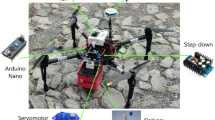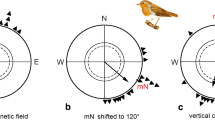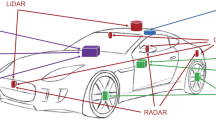Abstract
Some authors have proposed that homing pigeons are able to correct the error in orientation following a phase-shift treatment by using the magnetic compass reference. They reported that clock-shifted pigeons bearing magnets display a greater deflection compared to magnetically unmanipulated clock-shifted birds. However, this hypothesis tested by recording pigeons’ vanishing bearings has led to contradictory results. The present study reports pigeons’ tracks recorded with a GPS and shows that clock-shifted pigeons bearing magnets displayed a greater deviation through the whole route compared to the magnetically unmanipulated shifted pigeons. Moreover, the analysis of the tracks shows that the birds belonging to both experimental groups stop in coincidence with their subjective night. When re-starting their journey, the birds corrected the clock-shift induced error in orientation, but the magnetically manipulated pigeons were less efficient in doing so. Our results are consistent with the hypothesis that homing pigeons released from unfamiliar location re-orient after clock shift by using the magnetic compass.





Similar content being viewed by others
References
Batschelet E (1981) Circular statistics in biology. Academic, London
Bingman VP, Ioalè P (1989) Initial orientation of anosmic homing pigeons based on information gathered at familiar release sites remains homeward directed following clock-shift. Behaviour 110:1–4
Binkley S, Mosher K (1989) Advancing schedules and constant light produce faster resynchronization of circadian rhythms. Chronobiol Int 6:305–311
Biro D, Freeman R, Meade J, Roberts S, Guilford T (2007) Pigeons combine compass and landmarks guidance in familiar route navigation. Proc Natl Acad Sci U S A 104:7471–7476
Bonadonna F, Holland R, Dall’Antonia L, Guilford T, Benvenuti S (2000) Tracking clock-shifted homing pigeons from familiar release sites. J Exp Biol 203:207–212
Foà A, Albonetti E (1980) Does familiarity with the release site influence the initial orientation of homing pigeons? Experiments with clock-shifted birds. Z Tierpsychol 54:327–338
Füller E, Kowalski U, Wiltschko R (1983) Orientation of homing pigeons: compass orientation vs piloting by familiar landmarks. J Comp Physiol 153:55–58
Gagliardo A, Ioalè P, Bingman VP (1999) Homing in pigeons: the role of the hippocampal formation in the representation of landmarks used for navigation. J Neurosci 19:311–315
Gagliardo A, Odetti F, Ioalè P, Bingman VP, Tuttle S, Vallortigara G (2002) Bilateral participation of the hippocampus in familiar landmark navigation by homing pigeons. Behav Brain Res 136:201–209
Gagliardo A, Odetti F, Ioalè P (2005) Factors reducing the expected deflection in initial orientation in clock-shifted homing pigeons. J Exp Biol 208:469–478
Holland R, Bonadonna F, Dall’Antonia L, Benvenuti S, Burt DP, Guilford T (2000) Short distance phase shifts revisited: tracking clock-shifted homing pigeons (Rock Dove Columba livia) close to the loft. Ibis 142:111–118
Ioalè P (1984) Magnets and pigeon orientation. Monit Zool Ital (N S) 18:347–358
Ioalè P (1995) Preferred compass directions of homing pigeons in Italy. Boll Zool 62:13–21
Ioalè P, Odetti F, Gagliardo A (2006) Do bearing magnets affect the extent of deflection in clock-shifted homing pigeons? Behav Ecol Sociobiol 60:516–521
Kramer G (1953) Die Sonnenorientierung der Vögel. Verh Dtsch Ges Zool 1952:77–88
Lipp H-P, Vyssotski AL, Wolfer DP, Renaudineau S, Savini M, Tröster G, Dell’Omo G (2004) Pigeon homing along highways and exits. Curr Biol 14:1239–1249
Luschi P, Dall’Antonia P (1993) Anosmic pigeons orient from familiar sites by relying on the map-and-compass mechanism. Anim Behav 46:1195–1203
Neuss M, Wallraff HG (1988) Orientation of displaced homing pigeons with shifted circadian clocks: prediction vs observation. Naturwissenschaften 75:363–365
Papi F, Ioalè P, Dall’Antonia P, Benvenuti S (1991) Homing strategies of pigeons investigated by clock shift and flight path reconstruction. Naturwissenschaften 78:370–373
Pardi L, Ugolini A, Faqi AS, Scapini F, Ercolini A (1988) Zonal recovering in equatorial sandhoppers: interaction between magnetic and solar orientation. In: Chelazzi G, Vannini M (eds) Behavioral adaptation to itertidal life. Plenum Publishing Corporation, London, pp 79–92
Ranvaud RD, Gasparotto OC, Britto LRG (1996) Backup compass mechanisms in pigeon orientation with the sun in the zenith. Brazilian J Med Biol Res 29:1341–1347
Schiffner I, Wiltschko R (2009) Point of decision: when do pigeons decide to head home? Naturwissenschaften 96:251–258
Schmidt-Koenig K (1958) Experimentelle Einflußnahme auf die 24-Stundenperiodik bei Brieftauben und deren Auswirkungen unter besonderer Berücksichtigung des Heimfindevermögens. Z Tierpsychol 15:301–331
Schmidt-Koenig K (1961) Die Sonne als Kompaß im Heim-Orientierungssystem der Brieftauben. Z Tierpsychol 18:221–244
Steiner I, Bürgi C, Werffeli S, Dell’Omo G, Valenti P, Tröster G, Wolfer DP, Lipp H-P (2000) A GPS logger and software for analysis of homing in pigeons and small mammals. Physiol Behav 71:589–596
Wallraff HG (1978) The preferred compass direction in initial orientation of homing pigeons. In: Schmidt-Koenig K, Keeton WT (eds) Animal migration, navigation and homing. Springer, Berlin, pp 171–183
Wallraff HG, Foà A (1982) The role of olfaction and magnetism in pigeons homing. Naturwissenschaften 69:504
Wiltschko R, Wiltschko W (2001) Clock-shift experiments with homing pigeons: a compromise between solar and magnetic information? Behav Ecol Sociobiol 49:393–400
Wiltschko R, Kumpfmuller R, Muth R, Wiltschko W (1994) Pigeon homing: the effect of a clock-shift is often smaller than predicted. Behav Ecol Sociobiol 35:63–73
Wiltschko R, Siegmund B, Stapput K (2005) Navigational strategies of homing pigeons at familiar sites: do landmarks reduce the deflections induced by clock-shifting? Behav Ecol Sociobiol 59:303–312
Acknowledgements
We thank Fabio Chini, Roberto Guidi and Andrea Guidi for their help in performing the experiment and Daniele Santerini for his help in the figure preparation.
Author information
Authors and Affiliations
Corresponding author
Additional information
Communicated by W. Wiltschko
Electronic supplementary material
Below is the link to the electronic supplementary material.
Electronic Material Table 1
Deviation from the home direction displayed by the unshifted control pigeons (C; DOC 46 kb)
Electronic Material Table 2
Deviation from the control group (C) mean direction displayed by the clock-shifted pigeons (S; DOC 54 kb)
Electronic Material Table 3
Deviation from the control group (C) mean direction displayed by the clock-shifted pigeons bearing magnets (SM; DOC 56 kb)
Electronic Material Table 4
Deviation from the control group (C) mean direction displayed by the clock-shifted pigeons (S), expressed as percentage of the expected deflection (DOC 49 kb)
Electronic Material Table 5
Deviation from the control group (C) mean direction displayed by the clock-shifted pigeons bearing magnets (SM), expressed as percentage of the expected deflection (DOC 49 kb)
Rights and permissions
About this article
Cite this article
Gagliardo, A., Savini, M., De Santis, A. et al. Re-orientation in clock-shifted homing pigeons subjected to a magnetic disturbance: a study with GPS data loggers. Behav Ecol Sociobiol 64, 289–296 (2009). https://doi.org/10.1007/s00265-009-0847-x
Received:
Revised:
Accepted:
Published:
Issue Date:
DOI: https://doi.org/10.1007/s00265-009-0847-x




